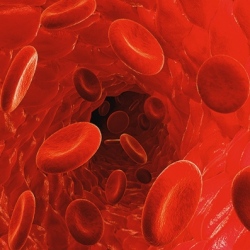
A blood test that distinguishes tumor DNA from altered non-tumor DNA detected cancer-related mutations in over half of patients with early-stage cancers. Using targeted error correction sequencing, they identified 59% to 71% of stage I-II colorectal, breast, lung, and ovarian cancers.
Retrospective comparison with tumor biopsy specimens showed good correlation between tissue and blood-test results, according to Victor Velculescu, MD, PhD, of Johns Hopkins in Baltimore, and colleagues.
In the subgroup of patients with resectable colorectal cancer, higher preoperative levels of circulating DNA correlated with disease recurrence and worse survival, they reported in Science Translational Medicine.
Acknowledging that "a lot of work in liquid biopsies in general" is ongoing, Velculescu pointed to distinguishing features of the study.
"Almost all of the studies have involved patients with late-stage cancer or used information from tumor specimens to go back and look in the blood of those patients," he told MedPage Today. "This is one of the first studies to use an unbiased approach — you don’t know where the mutations are going to be — and to look at the blood of early-stage cancer patients to see whether we could detect alterations."
"It’s actually very hard to find these mutations in the blood, especially when you don’t know what the mutations are upfront," he added. "There are a number of confounding errors that can come up. Besides sequencing and technical errors, you can get alterations that come from the germline and can also get mutations that come from blood cells. We developed a way in which you could distinguish tumor driver mutations from these other alterations that might be in the blood."
The study added to the growing volume of information about "liquid biopsies" for cancer diagnosis and other potential applications in cancer management. Development of noninvasive ways to identify cancer in early stages of development has proven challenging.
Many well-established cancer biomarkers also occur in the absence of cancer — such as cancer antigen (CA) 125, CA-19, carcinoembryonic antigen, and prostate-specific antigen. Other diagnostic strategies are tumor specific, such as stool-based molecular tests and colonoscopy for colon cancer.
Proposed use of circulating cell-free (cf) DNA as a diagnostic strategy dates back several decades, but only recently did the technology emerge to permit identification of abnormalities in cfDNA in patients, the authors continued. Evolution of next-generation sequencing and advances in computing science allowed cfDNA-based genotyping for several types of cancer, but studies to date primarily involved patients with late-stage cancers or use of tumor tissue to guide blood analyses.
Velculescu’s group reported findings from a direct analysis of common sequence alterations in cfDNA without guidance from tumor specimens. Investigators analyzed plasma samples from a total of 194 patients, consisting of 45 patients with breast cancer, 42 with colorectal cancer, 65 with lung cancer, and 42 with ovarian cancer. The total study population included 138 patients with stage I or II disease. For comparison, investigators analyzed blood samples from 44 healthy individuals without cancer.
Each blood sample was screened with a panel of 58 genes commonly associated with a variety of cancers. The patients had significantly higher concentrations of cfDNA (29 ng/mL versus 7 ng/mL in the healthy control group, P=0.001). In the colorectal cancer subgroup, patients with stage IV disease had a significantly higher cfDNA concentration compared with patients who had stages I-III cancer (66 versus 21 ng/mL, P=0.006).
The authors found that three-fourths of patients with colorectal cancer had detectable alterations in driver genes, as did two-thirds of patients with the other cancer types. For each tumor type, the affected genes and types of alterations were similar to previously reported common driver alterations.
The test’s diagnostic accuracy increased with disease stage for each tumor type. In the colorectal subgroup, the test predicted cancer in four of eight patients with stage I disease, eight of nine with stage II disease, nine of 10 with stage III, and 14 of 15 with stage IV. In the lung cancer cohort, the test predicted 13 of 29 stage I cancers and 23 of 32 stage II cancers. The test predicted 16 of 24 stage I ovarian cancers and three of four stage II cancers, as well as two of three stage I breast cancers and 17 of 29 stage II cancers.
The test found no cancer-associated mutations in blood samples from the 44 healthy individuals.
Velculescu said the next steps for the test will be to expand the investigation to include more patients, and with different tumor types, and to conduct clinical trials to determine the impact of early detection on clinical outcomes. The test can be adapted to incorporate new information about cancer genomics and driver genes, and the technology has the potential for use in cancer screening and monitoring patients during treatment.
